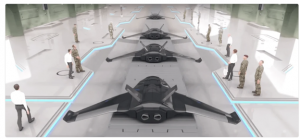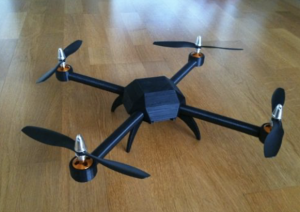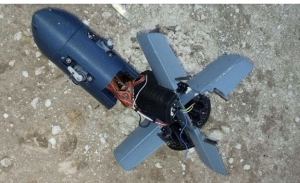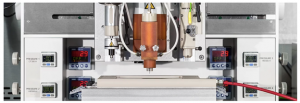17 Unique Challenges of Responding to Bioterrorism & Chemical Threats & Attacks Delivered by Drones
By Dr. Suzanne Sincavage & Professor Candice M. Carter
STUDENT OBJECTIVES
- What are the national security risks posed by the advancement of emerging robotic technologies and their enabling effects in the bioweapons/Weapons of Mass Destruction (WMD) space?
- What potential platforms exist for delivering biological weapons (BW) used by terrorists?
- What new opportunities or solutions do advanced robotics offer to national security problems and/or their challenges in countering chemical threats?
- What challenges and opportunities exist for global governance to mitigate the CBRN risk?
INTRODUCTION
The convergence of drone and 3D printing technologies may allow terrorists to acquire CBRN weapons with minimal identifiable signatures. (Kallenborn, 2019) As technology continues to evolve, its availability becomes more common and attractive to all levels of threat actors. The use of explosive-laden quadcopter drones to try to assassinate the Iraqi prime minister, Mustafa al-Kadhimi, at his residence in November 2021 was yet another wake-up call about the utility of small drones to armed non-state groups and the dangers they pose when operated by people who embrace violence to effect change. (Rassler & al-‘Ubaydi, 2021) Modified drones for chemical and bioterrorism attacks by terrorist organizations might not look like Nation-state actors, but the drones still provide the element of surprise and damaging attack.
ADVANCED ROBOTICS
Advanced robotics generates both new risks and opportunities for the WMD
space. Increasingly, sophisticated robots are available commercially for industrial and domestic use, with commercial drones at the forefront of this trend. Whereas commercial drones offer states and nonstate actors a potential delivery system for WMD, the wide range of robotics across the sea, land, and air domains enhances defense capabilities for countering WMD by providing agile and cheap platforms for detecting WMD operating in hazardous environments.
ROBOTICS: Technology Overview
The development of advanced robotics, a branch of mechanical engineering, electrical engineering, and computer science, began in the 1960s with a basic robotic arm designed to perform difficult or too dangerous tasks for humans. The field of advanced robotics has been tracked closely with advances in computing, artificial intelligence (AI), and energy storage. Today, increasingly sophisticated robots are widely available on the commercial market, and prices are dropping dramatically, expanding their use. (Brown, 2014) A robot is a reprogrammable, multifunctional manipulator designed to move material, parts, tools, or specialized devices through various programmed functions to perform various tasks. (Brown, 2014) All robots have certain defining features, including a mechanical structure designed to carry out a specific task, electrical components that power and control the machinery, and some level of computer programming code.
Artificial intelligence refers to the near-human, human, or super-human ability to respond to a complex environment. Robots are intelligent systems that apply a certain level of AI to a specific problem or domain. The sophistication of the computer program embedded in a robot determines its level of autonomy and the nature of its human oversight. Weak artificial intelligence, the cognitive ability to solve specific problems or perform certain tasks, has supported many applications for many decades. (Brown, 2014) Humans control robots using weak AI. A remote-control robot has programmed with a preexisting set of commands that it will perform when it receives a signal from a control source, typically a human with remote control. This is called “in the loop,” where a human confirms actions, denies actions outside designed constraints and denies actions outside the operational context.
On the opposite side of the spectrum are autonomous robots, which are intelligent machines capable of performing tasks in the world by themselves, normally requiring human intelligence (e.g., perception, conversation, decision-making) without explicit human control. This is referred to as “out of the loop” since machines function without the ability of humans to intervene. To be autonomous, a system must have the capability to independently compose and select among different courses of action to accomplish goals based on its knowledge and understanding of the world, itself, and the situation.
In the future, robots will be increasingly able to operate autonomously
without human intervention. Hybrid systems involve both elements of human control and autonomy. This is referred to as “on the loop,” where a human can allow actions outside designed constraints or the operational context to take advantage of evolving context.
In addition to different levels of complexity, robots can be developed to address many types of problems or for use in and across many different domains, including industry, commerce, land, sea, and air. Of these domains, UAVs (or “drones” as they are popularly known) are taking off in the civilian and commercial sectors.
Industry experts are hailing 2016 as the dawn of the drone age. Consumer sales are expected to reach four million in 2016 and 16 million by 2020. The number of operators of drones, both large and small, is rising rapidly. Many affordable commercial drones offer significant off-the-shelf capabilities. UAV technology has enabled thousands of individuals to enter the field of aviation with comparably little training and oversight and the growing market for civilian drones.
Companies like Amazon and Google, among others, are developing drones as a platform for making rapid deliveries across cities. According to the Federal Aviation Administration, the most significant uses of UAVs come from agriculture, photography, and mapping. In the agricultural sector, for example, drones allow for precision farming. This method reduces the number of chemicals sprayed on crops by precisely dusting crops. Drones can also fly close to the ground and stream videos to allow producers to be more efficient in addressing growth issues and even monitoring unexpected pests. This can help farmers address water damage or dryness levels and aid in monitoring large crops that need a lot of attention.
Although robotics is becoming more accessible, cheaper systems remain limited in autonomy and capabilities. The utility of drones for many applications is constrained by range, flight time, and payload or carry weight (enabled by battery/energy storage). Typically, there are trade-offs between flight time and weight. The heavier the carry weight,
the shorter the flight time. Much of the promise of robotics remains a prospect of the future. Engineers have thus far not been able to build a machine capable of human-like cognition. However, advances in computing and energy storage may offer near-term leaps in advanced robotics.
3D PRINTING
3D printers can be used to create equipment components at reduced cost and have been used to create bioreactors, microscopes, and other key elements. (Kallenborn, 2019). The digital build-files for 3D printed items can also be sent and received online, perhaps from black market sellers or individuals sympathetic to the terrorist’s ideology. (Kallenborn, 2019) 3D printers make it possible to create a custom drone to deliver a CBRN attack.
Professor Lee Cronin from the University of Glasgow has trademarked the process called “chemputer.” Chemputer uses intelligent biomatter to 3D print drones and planes, giving militaries a huge advantage in the new frontier of warfare.
Figure 17.1 Chemputer Drones

Source: (Watkin, 2016)
“We have been developing routes to digitize synthetic and materials chemistry and at some point, in the future, hope to assemble complex objects in a machine from the bottom up or with minimal human assistance. Creating small aircraft would be very challenging, but I’m confident that creative thinking and convergent digital technologies will eventually lead to the digital programming of complex chemical and material systems,” states Professor Lee Cronin. (Watkin, 2016)
Figure 17.2 3D Printed Drone

Source: (Global Guerrillas, 2012)
Converging with 3D printing, some drones can now be printed relatively quickly; they are lighter, travel farther, and have a greater capacity to carry payloads than other remote-controlled electronics. For example, researchers at the University of Virginia were tasked to create a drone similar to current military drones, but that could be 3D-printed and used only off-the-shelf parts. The Razor drone is tailorable to meet operational needs and is capable of variable flight time (45+ minutes) and speeds (40+ mph). Its cost was about $2,500, most of which was for the cellphone that acts as the entire electronics package of the drone and is capable of command and control via cell signal. The Razor drone can be built in just over 24 hours. The costs are expected to drop even further.
In March 2014, engineers in the United Kingdom successfully developed a 3D-printed drone that cost $9 per copy and could be built and assembled in less than 24 hours. If a non-state actor group acquired the blueprint and ten printers, it could print 10 per day and 300 per month at the cost of $2,700 plus the cost of the printers.
Figure 17.3 ISIS 3D Printed Bomb

Source: (Koslow, 2016)
BIOPRINTERS
Bioprinting uses 3D printing-like techniques to combine cells, growth factors, and biomaterials – collectively named ‘bioinks’ – to create living tissues that almost perfectly mimic their structure in the body. (Pavey, 2021) Bioinks are deposited layer by layer onto a supporting hydrogel, which functions like paper in conventional printing. (Pavey, 2021) However, unlike normal printing, the hydrogel dissolves once the product matures, leaving it freestanding. (Pavey, 2021) This is a remarkable advancement for drug research, fighting human disease, and creating customized medicine. However, this opens the door for a great amount of evil. This could be used to create custom poison, bioprinted killer bacteria, and recreate a vaccine to be lethal to the global community. Researchers at Rutgers-New Brunswick School of Engineering believe they have found a way to protect against using 3D printing for evil. The first solution focuses on designing a sensor that can measure the composition and diameter of raw materials passing through the printer’s extruder to ensure they meet expectations before the object is printed. A dielectric sensor can detect a change of 0.1mm in filament diameters and a change of 10% in concentration composition. (RUTGERS UNIVERSITY, 2021) The second solution uses high-resolution computed tomography images to detect residual stresses in printed objects that contrast benign and malicious designs before activation of the attack. This CT detection has an accuracy of 94.6% in identifying 4D attacks in a single printing layer. (RUTGERS UNIVERSITY, 2021), 2021) The researchers are also working on combining the above solutions with software security, control system design, and processing signals. This would be a valuable solution in protecting the use of 3D printing technology for evil.
Figure 17.4 3D Bioprinter

Source: (Pavey, 2021)
U.S. Defense Threat Reduction Agency (DTRA) provided the researchers at Wake Forest University with $24 million to aid their research and development in combating nuclear, chemical, and biological weapons. (Decker, 2013) The WFU lab uses “Body on a Chip” to replicate the cells that function as organs in the human body. With this capability, the scientists can see how the cells act when exposed to specific chemical and biological weapons to find the right treatment for survival.
THE RISKS
Among the wide range of robotics coming of age in the near term, policymakers are most immediately concerned about the use of hobbyist and commercial drones for potential mischief by non-state actors and the development of advanced UAVs by state actors as an asymmetrical capability vis-à-vis high-tech platforms such as fighter jets. Enabling aerial operations, drones can provide unfettered access to targets in ways that terrorists could previously only dream about and security planners have not had to worry about. Airborne
improvised explosive devices (IEDs) could be used to attack people, infrastructure, or aircraft, among many other possible targets, where large destructive power may not be necessary to cause tremendous amounts of damage. Hobbyist drones have limited payloads and ranges but can still be used for disproportionate effects. For example, in September 2013 in Germany, a political protester flew a drone within feet of German Chancellor Angela Merkel and Defense Minister Thomas de Maiziere before it crash-landed next to them. Armed with even a small amount of
explosive fragments or shrapnel could have killed or maimed two members of Germany’s leadership.
In early November 2014, multiple drones were sighted over French nuclear power plants in what was described as a “provocation of French authorities.” A squadron of drones armed with explosives and detonated in certain positions may be able to cause significant damage to expensive infrastructure. Military aircraft and other high-technology platforms are not immune to this threat. A small number of expendable drones could cause considerable damage to a military aircraft costing hundreds of millions of dollars. The number of drones is scalable, whereas the physical capability of each drone limits explosive capacity.
In 2009, US Airways Flight 1549 had to make an emergency landing on the Hudson River after colliding with a gaggle of Canada geese. Compared to a bird, a drone consisting of metal, hard plastics, batteries, and electronics could do far more damage and potentially take down a passenger jet.
As advances in artificial intelligence are mated with drone technology, drones will begin to perform previously pilot-controlled tasks (navigation, coordination, targeting) autonomously, without the need for input from the primary operator. Multiple drones possessing these autonomous capabilities could “swarm” a target and offer a powerful asymmetric capability to states and non-state actors.
Carrying biological, chemical, or radiological materials, drones offer an extremely agile delivery platform for WMD, even if they are still limited to a small payload. On 24 April 2015, a Japanese man landed a drone containing radioactive material on the roof of Japanese Prime Minister Shinzo Abe’s office to protest Japan’s nuclear energy policy.
In October 2016, ISIS used a drone loaded with explosives for the first time in an attack that killed two soldiers and injured two others. Given the use of chlorine and mustard agents by ISIS, it is conceivable that insurgents might use drones as delivery vehicles for chemical and biological agents shortly.
Drones flown in overcrowded venues or around aircraft at airports do not have to be lethally armed to lead to panicked responses from people, companies, and authorities and, therefore, could be used to instill fear into a target.
THE OPPORTUNITIES
Advanced robotics offer ideal platforms to perform dangerous counter-WMD missions, including surveillance and detection, decontamination, and operations. Cheap, expendable, and often tiny in size, robotics offers a powerful surveillance and detection missions tool. The U.S. Army is developing Micro Autonomous Systems and Technology (MAST). These tiny insect-shaped ground and aerial robots are designed to assist soldiers with rapid and mobile intelligence, surveillance, and reconnaissance missions in high-risk zones.
Microbots can capitalize on their size to move quietly and easily access small spaces. If a unit approaches a building and needs to know what is inside, the soldiers could deploy a reconnaissance team of microbots. The robots could penetrate the building undetected, search the interior, map the layout, and provide data on its occupants and locations.
The U.S. Army also developed the WMD Aerial Collection System, an unmanned capability designed to assess the presence of airborne CBRN material during military operations. The UAV mounted with trackers and collectors can locate, intercept, and collect aerial samples from a CBRN plume for analysis in a laboratory facility. The system allows for in-flight detection reporting.
Enhanced by AI and 3D printing technologies, small teams of MAST robots
are being designed to be autonomous and capable of coordination or “swarming.” These robots are envisioned to support soldiers with improved tactical situational awareness in urban and complex terrain. In the future, the U.S. Army hopes to be able to 3D-print drones while on a mission in less than 24 hours.
Robotics are ideal platforms for detecting the presence of CBRN materials in hostile areas. The U.S. Army partnered with Carnegie Mellon University and Sikorsky Aircraft to design an autonomous ground vehicle delivered by UAV (modified Black Hawk helicopter) into hostile or inaccessible areas equipped with chemical, biological and radiological sensors for missions in contaminated areas.
Robots can safely operate in hazardous environments and assist in counter-WMD missions, including decontamination and operations. The U.S. Army is working to develop a robot capable of locating, lifting, and carrying wounded soldiers out of dangerous zones to safety for treatment. The Battlefield Extraction-Assist Robot (BEAR) is currently designed to be remote-controlled by combat medics, but developers are working on expanding its capacity to assume semi-autonomous tasks. The BEAR has a “teddy bear” face to reassure injured soldiers and can be used for other missions such as search and rescue, handling hazardous materials, surveillance, reconnaissance, mine inspection, lifting hospital patients, or even warehouse automation.
Leveraging robots’ ability to operate in hazardous environments, the Department of Defense contracted with Boston Dynamics and the Midwest Research Institute to create a robot capable of testing chemical warfare suits called the PETMAN. Once completed, the PETMAN weighed 180 pounds and could run 4.4 mph on smooth surfaces. Tests conducted with these robots ensure that the suits maintain their integrity in a contaminated environment while moving the same way a human would.
The U.S. Navy has developed the Battlespace Preparation Autonomous Underwater Vehicle (BPAUV), a small, fast, autonomous underwater robot, primarily to handle its mine countermeasure mission in shallow water. With its compact size and accurate navigation, the BPAUV can be operated from a ship or boat, function in various weather conditions, and collect high-quality imagery necessary for successful operations. Other applications include unexploded ordnance, anti-submarine warfare, and oceanography.
CONCLUSIONS
Robotics offers powerful and often cheap platforms for performing various tasks. For non-state actors, drones may serve as a readily available delivery platform for an IED or WMD. For advanced states and militaries, robotics offer significant advantages for operating in hazardous environments on land, the sea, and the air. L.G. Shattuck, “Transitioning to Autonomy: A Humans Systems Integration Perspective,” paper presented at the Autonomy Workshop, NASA Ames Conference Center, Moffett Field. As defined by Kadte and Wells.
The Department of Defense defines unmanned aerial vehicles (UAVs) as powered aerial vehicles that do not carry a human operator, use aerodynamic forces to provide vehicle lift, fly autonomously or be piloted remotely, and be expendable or expendable recoverable, and can carry a lethal or nonlethal payload. Noteworthy incidents and insights from failed experiments, the interplay between defensive and offensive innovations, asymmetric mirror-imaging, hobbyist innovation, and enhancements for commercial products would provide additional layers to allow analysts to track better and anticipate relevant changes taking place across an innovation ecosystem comprising terrorist, hobbyist, industry, and state activity. (Rassler & al-‘Ubaydi, 2021) Such an approach would help governments better prepare for new, creative, and innovative approaches that terrorists might use tomorrow and in the years ahead. (Rassler & al-‘Ubaydi, 2021)
Bibliography
Atherton, K. D. (2016, February 19). Army Wants Drones On-Demand, 3D-Printed In 24 Hours Or Less. Retrieved April 11, 2022, from Popular Science: https://www.popsci.com/army-wants-to-3d-print-drones-in-24-hours/
Benedict, J. R. (2016, October 1). Global Power Distribution and Warfighting in the 21st Century. Retrieved April 11, 2022 from NDU Press: https://ndupress.ndu.edu/Media/News/Article/969640/global-power-distribution-and-warfighting-in-the-21st-century/
BLUEFIN Robotics. (2010). Bluefin-21 BPAUV. Retrieved April 11, 2022 from Bluefin-21 BPAUV: https://gdmissionsystems.com/-/media/General-Dynamics/Maritime-and-Strategic-Systems/Bluefin/PDF/Bluefin-21-BPAUV-Product-Sheet.ashx?la=en&hash=DA69EC6FF1F9BA7499D171454DB8CCCDC7E6F479
Brown, M. (2014, September 30). Extending the Reach of the Warfighter through Robotics (ERWR). Retrieved April 11, 2022 from DVIDS: https://www.dvidshub.net/video/363784/extending-reach-warfighter-through-robotics-erwr
Crawford, J. (2016, October 20). Report warns of ISIS developing drones for chemical attacks. Retrieved April 11, 2022 from CNN: https://www.cnn.com/2016/10/20/politics/terrorist-groups-and-drones/index.html
Davis, L. E. (2016, October 11). Remotely Piloted Innovation. Retrieved April 11, 2022 from DTIC: https://ctc.usma.edu/wp-content/uploads/2016/10/Drones-Report.pdf
Dean, T. R. (2014, May 16). Researchers consider miniature robots to enhance capabilities | Article | The United States Army. Retrieved April 11, 2022 from U.S. Army: https://www.army.mil/article/125337/Researchers_consider_miniature_robots_to_enhance_capabilities/
Decker, B. (2013, September 30). Bioprinting to Test Antidotes for Chemical Weapons. Retrieved April 11, 2022 from Bioprinting World: http://bioprintingworld.com/bioprinting-to-test-antidotes-for-chemical-weapons/
Defense Daily Network. (2008, September 30). DTRA Seeks Info on WMD Aerial Collection System. Retrieved April 11, 2022 from Defense Daily: https://www.defensedaily.com/dtra-seeks-info-on-wmd-aerial-collection-system/homeland-security/
Demonic, M. R., & Mills, M. E. (2021, August 12). 2014 NDIA GROUND VEHICLE SYSTEMS ENGINEERING AND TECHNOLOGY SYMPOSIUM AUGUST 12-14 NOVI, MICHIGAN Extending the Reach of the Wa. Retrieved April 11, 2022 from Ground Vehicle Systems Engineering and Technology Symposium (GVSETS) & Advanced Planning Briefings for Industry (APBI): http://gvsets.ndia-mich.org/documents/AAIR/2014/Extending%20the%20Reach%20of%20the%20Warfighter%20through%20Robotics%20-%20Autonomous%20Execution%20of%20a%20Tactical%20Resupply%20and%20Surveillance%20Mission.pdf
Global Biodefense Staff. (2022, February 25). Biodefense Headlines – 25 February 2022. Retrieved April 11, 2022 from Global Biodefense: https://globalbiodefense.com/2022/02/25/biodefense-headlines-25-february-2022/
Global Guerrillas. (2012, February 17). Print Your Own Drone: Free Designs and Tools. Retrieved April 11, 2022 from Global Guerrillas: https://globalguerrillas.typepad.com/globalguerrillas/2012/02/print-your-own-drone-free-designs-and-tools.html
Golson, J. (2014, September 16). A Military-Grade Drone That Can Be Printed Anywhere. Retrieved April 11, 2022 from WIRED: https://www.wired.com/2014/09/military-grade-drone-can-printed-anywhere/
Hammes, T. X. (2016, January 27). Technologies Converge and Power Diffuses: The Evolution of Small, Smart, and Cheap Weapons. Retrieved April 11, 2022 from Cato Institute: https://www.cato.org/policy-analysis/technologies-converge-power-diffuses-evolution-small-smart-cheap-weapons
Heine, V. (2013, September 16). Merkel Campaign Event Visited by Mini Drone. Retrieved April 11, 2022 from Spiegel: https://www.spiegel.de/international/germany/merkel-campaign-event-visited-by-mini-drone-a-922495.html
Kallenborn, Z. (2019, September 9). 174. A New Age of Terror: The Future of CBRN Terrorism. Retrieved April 11, 2022 from Mad Scientist Laboratory: https://madsciblog.tradoc.army.mil/174-a-new-age-of-terror-the-future-of-cbrn-terrorism/
Koslow, T. (2016, December 6). Concerns Mount Over ISIS Making 3D Printed Bombs. Retrieved April 11, 2022 from All3DP: https://all3dp.com/3d-printed-bombs-isis/
Lichfield, J. (2014, November 9). French government on high alert after unexplained drone flights over nuclear power stations | The Independent. Retrieved April 11, 2022 from The Independent: https://www.independent.co.uk/news/world/europe/french-government-on-high-alert-after-unexplained-drone-flights-over-nuclear-power-stations-9850138.html
NDU Press. (2016, April 26). Cheap Technology Will Challenge US Tactical Dominance – Analysis. Retrieved April 11, 2022 from Eurasia Review: https://www.eurasiareview.com/26042016-cheap-technology-will-challenge-us-tactical-dominance-analysis/
Pavey, A. (2021, March 26). Bioprinting: a myriad of (t)issues — Science Entrepreneur Club. Retrieved April 11, 2022 from The Science Entrepreneur Club: https://www.science-entrepreneur.com/blog-1/bioprinting-a-myriad-of-tissues
Quick, D. (2010, November 25). Battlefield Extraction-Assist Robot to ferry wounded to safety. Retrieved April 11, 2022 from New Atlas: https://newatlas.com/battlefield-extraction-assist-robot/17059/
Rassler, D., & al-‘Ubaydi, M. (2021, December 12). Anticipating Future Directions of Tech-Enabled Terror. Retrieved April 11, 2022 from Lawfare Blog: https://www.lawfareblog.com/anticipating-future-directions-tech-enabled-terror
RUTGERS UNIVERSITY. (2021, December 10). New Cyber Protections Against Stealthy “Logic Bombs” Targeting 3D Printed Drones, Prostheses and Medical Devices. Retrieved April 11, 2022 from SciTechDaily: https://scitechdaily.com/new-cyber-protections-against-stealthy-logic-bombs-targeting-3d-printed-drones-prostheses-and-medical-devices/
Shattuck Ph.D., C. G. (2020, March 12). Transitioning to Autonomy: A Human Systems Integration Perspective Transitioning to Autonomy: A Human Systems Integration Perspe. Retrieved April 11, 2022 from Human Systems Integration Division: https://human-factors.arc.nasa.gov/workshop/autonomy/download/presentations/Shaddock%20.pdf
Thomas, A. (2008, June 20). Army Partners with Academia for Emergence of New Technology. Retrieved April 11, 2022 from Army.mil: https://www.army.mil/article/10227/army_partners_with_academia_for_emergence_of_new_technology
Topolsky, J. (2008, May 4). Bug-bot video reveals swarming drones, extreme rocking. Retrieved April 11, 2022 from Engadget: https://www.engadget.com/2008-05-04-bug-bot-video-reveals-swarming-drones-extreme-rocking.html
U.S. Department of Defense. (2001, April 12). Department of Defense Dictionary of Military and Associated Terms. Retrieved April 11, 2022 from JITC – Homepage: https://jitc.fhu.disa.mil/
U.S. NRC. (2011, August 2). US Airways Case Study 2, US Airways Flight 1549: Forced Landing on Hudson River. Retrieved April 11, 2022 from Nuclear Regulatory Commission: https://www.nrc.gov/docs/ML1122/ML11228A218.pdf
Watkin, H. (2016, July 6). Crazy Futuristic “Chemputer” Could Grow Drones. Retrieved April 11, 2022 from All3DP: https://all3dp.com/chemically-grow-drones-3d-printing/
Woollaston, V. (2014, March 28). Researchers successfully build and fly a low-cost DISPOSABLE drone. Retrieved April 11, 2022 from Daily Mail: https://www.dailymail.co.uk/sciencetech/article-2591533/Cheap-3D-printed-drones-coming-Researchers-successfully-build-fly-low-cost-DISPOSABLE-aircraft.html

